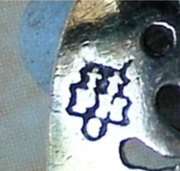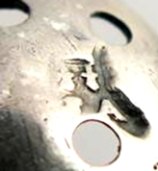(click on photos to enlarge image)
FURTHER REVELATIONS CONCERNING THE HARACHE WORKSHOP
Recent research into members of the Harache family of goldsmiths
who left France in the 17th century and settled in London
has revealed that a Peter Harache of Little
Newport Street was dealing with Richard Hoare the banker between
1697 and 1705 (see note 1).
According to E. Alfred Jones writing in The Burlington Magazine
for Connoisseurs (see note 2)
about casters made by him for Hoare, "In 1697 he made a set
of 'the common sort with heads graved, 41oz. 19dwt'". He
must then have been a working partner in the firm Pet; harache
&c goldsmiths and it now seems that this firm too was engaged in
banking, as David Willaume and other goldsmiths were, since an
entry in the list of goldsmith bankers compiled by F. G.
Hilton-Price in 1890-1 (see
note 3) reads: "Harache, Peter, Goldsmith and
plate-worker, of Suffolk Street, corner of Charing Cross,
1689-1706".
The difficulty in determining which Peter Harache was engaged in
which activity is that, although they worked as a company which
was based at Great Suffolk Street, their activities are recorded
under their individual names and there were three of them! Thus
Jones was under the impression that the Peter Harache who had
dealings with Hoare's bank was Peter Harache the younger, whose
address was at Compton Street and who didn’t enter his mark
until 1698, whereas the word 'younger' does not appear in the
records held at the bank and as Peter Harache the elder was
domiciled at Great Suffolk Street throughout this period it
seems that the Peter Harache in question was Peter Harache III.
The active large worker in the Harache workshop at Great Suffolk
Street after 1697 was Peter Harache I and there are extant
examples of his work in both museums and private collections
around the world although a mystery surrounds them as most have
been misattributed to Peter Harache II. The confusion arose
because Sir Ambrose Heal claimed that Peter Harache I died in
1700 (see note 4),
whereas his burial record is actually dated December 1712
(see note 5).
In fact Peter Harache II came from a family of small workers and
must himself have been a small worker. Both his younger brothers
Abraham and John (John Harache I), who also came to England are
known to have been small workers and both probably finished
their apprenticeships under the direction of their elder brother
since their father died before they had finishes their terms.
That this was a family of small workers is not surprising as
there appears to have been a division in 17th century France
along religious lines with Catholics as silversmiths and
Protestants as goldsmiths, the latter specialising in small
wares like decorative boxes such as snuff boxes. Peter Harache I
and David Willaume, both of whom were large workers, were
therefore the exception rather than the rule!
The only reason for believing that Peter Harache II, was a large
worker is that he has had items of large work attributed to him
as stated above, having entered marks in the large workers'
register (see note 6)
at Goldsmiths’ Hall in 1698, and this has led to acceptance that
he was indeed a large worker although it now seems that these
were misattributions. In 1703 he took Jacques Des Rumeaux as his
apprentice and according to Grimwade the brothers John and
Daniel Lefebvre were also apprenticed to him. All three entered
marks as small workers on gaining their freedom!
It has now become evident that early 18th century plate bearing
the Harache workshop mark is struck with the mark of Peter
Harache I which he registered in 1697
(see note 7). This is
hardly surprising since Peter Harache II was in receipt of Royal
Bounty from November 1714 which means that there were only
twenty two months between December 1712 and November 1714 during
which time work produced by the Company could have been struck
with any mark other than that of Peter Harache I. Further, since
Louis Mettayer became the rate payer at Great Suffolk Street
after 1712, it seems likely that the Company was wound up on the
death of Peter Harache I and that there would therefore have
been no plate produced after 1712 on which any workshop mark
pertaining to that Company could have been struck. It is a fact
that dishes dated 1713 (currently at The British Museum),
forming a set of six, are struck with Mettayer’s mark and this
shows that the workshop at Great Suffolk Street was being used
by him and not by the Company. On the other hand there are
examples of small work such as a long tea strainer (mote) spoon
and tea (sugar) tongs together with snuff and other miniature
spoons of both sterling and Britannia standard which must be
dated to the late 17th and early 18th centuries that are struck
with marks both registered and unregistered that can be no other
than the marks of Peter Harache II. (see below).
The conclusion to be drawn from the foregoing is that Peter
Harache II was not a large worker at all but, like his brothers
and his own apprentices, had been trained as a small worker. He
may well have worked with Peter Harache I at Great Suffolk
Street (or at Compton Street as an outworker) as a member of the
Harache Company, as his younger brother Abraham probably did,
but in the capacity of a small worker. Further it has now been
established that, as the Haraches traded as a Company, the large
workers’ marks registered by them must be treated as 'workshop'
marks so that Peter Harache II could have entered his large
marks as alternative workshop marks which, in fact, were never
used. This is borne out by the fact that one of the four marks
in the register against his name is offset and is much smaller
than the other three and it is this mark that appears on small
work of Britannia standard made by him and must be considered
personal to him (see below)(see
note 8).
Thus as now seems likely, it will be found that Peter Harache II
was a small worker and that all of the large work previously
attributed to him must be that of Peter Harache I or at least
struck with his mark, it is not surprising that the late Arthur
Grimwade compared the former's work so favourably with that of
the latter since it will have been shown that both were the
inspiration of one and the same man!
Grimwade attributed the engraving work found on pieces marked by
Peter Harache I to Blaise Gentot and that on pieces attributed
to Peter Harache II to Simon Gribelin and in view of the
foregoing it seems likely that Gribelin (1661-1733) may have
taken over from Gentot as the engraver to the Harache workshop
on the death of the latter in 1700.
If it is found that the post 1700 large work previously
attributed to Peter Harache II was the work of the Harache
Company and was struck with the mark of Peter Harache I as a
workshop mark but that the engraving work on all post 1682 plate
by the Harache workshop must be attributed to these two
engravers then there can be little doubt that Gribelin did take
over from Gentot.
 |
 |
Sterling mark of Peter
Harache II
(unregistered)
|
Britannia mark of Peter
Harache II
(registered)
|
As it must now be accepted that the Haraches worked at Great
Suffolk Street under the title ‘Pet; harache &c goldsmiths'
(see note 9) and that
the makers' marks appearing on their large work were workshop
marks then it follows that all large work marked by them must
now be attributed to Pet Harache &c goldsmiths and not to
individual silversmiths. This in turn means that any sterling
standard pieces therefore almost certainly bear the mark of
Peter Harache III whilst any Britannia standard pieces bear the
mark of Peter Harache I.
Further it now seems that it must be accepted that Peter Harache
II's marks, both registered and unregistered, are likely to be
found only on small work!
David McKinley
- 2012 -
David McKinley devotes much of his time to
researching the history of silversmithing in England
with particular reference to hallmarking at the London
office. He writes for both The Silver Spoon Club of
Great Britain and The Silver Society.
David McKinley is the author of the book THE FIRST
HUGUENOT SILVERSMITHS OF LONDON
Information about the content of this book and the
discounted price applied to members of ASCAS is
available in
September 2011 Newsletter
|
|


